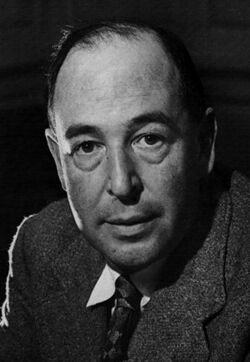C. S. Lewis

Clive Staples Lewis (better known as "C. S.", not to be confused with C. S. Goto (how dare you confuse the two), nor with Lewis Carroll) was J. R. R. Tolkien's good friend and another influential early modern fantasy writer. He was also an essayist and a theologian; one of his essays "Religion and Rocketry" discussed hypothetical ideas and how the existence of aliens would not clash with Christianity. In the modern day, he's best known for The Chronicles of Narnia series.
His Fictional Works
- The Space Trilogy
- Out of the Silent Planet (1938)
- Perelandra (1972)
- That Hideous Strength (1974) (AKA That Hideous Book, according to JRR Tolkien).
- The Chronicles of Narnia (1950-1956)
- The Magician's Nephew (actually a prequel to The Lion, the Witch, and the Wardrobe)
- The Lion, the Witch and the Wardrobe
- The Horse and His Boy
- Prince Caspian
- The Voyage of the Dawn Treader
- The Silver Chair
- The Last Battle
- The Screwtape Letters
- The Pilgrim's Regress
- The Great Divorce
- Till We Have Faces
Why He Was Influential
With the Narnia series, C. S. Lewis brought to the table the "everything in mythology but the kitchen sink" approach to fantasy writing. Norse, Greco-Roman, Folklore, Judeo-Christian (more on that later), even modern things like Santa Claus got worked in. If Tolkien gave modern fantasy RPGs Halflings, Orcs and Dark Lords, Lewis gave them Centaurs, Minotaurs, Merfolk, and talking animals. Narnia also included one of the earliest examples of the "secret magical world parallel to our own" trope.
Lewis' books about the afterlife are particularly unique. The Screwtape letters, for example, is a fictional series of letters written by a demon, Screwtape, to his nephew Wormwood, giving him advice on seducing a man to the ways of sin and damnation. In it, Hell isn't depicted as a brutal prison as in Dante's Inferno, but more like a diabolical bureaucracy. Demons consume human souls as we would consume wine, and the more evil they are, the finer their vintage. Screwtape gives excellent advice on how to manipulate good intentions into bad deeds, and the book's unusual point of view lends itself to some creative ideas. Suffice to say it's an excellent read for GMs wishing to run a particularly cunning or seductive demon.
On His Writing
Tolkien had his beliefs and viewpoints and they manifested in his writings. His religious beliefs, preference for the English Countryside and Forests, his dislike of pollution and the destruction of wild spaces by Industrialists all come up in The Lord of the Rings and The Hobbit, though they come up as background details and a component of greater world building. In contrast, for Lewis wrote his works with the intent to expose his viewpoints to the audience. They are far more preachy, often in a literal sense as they preach Christianity. The Narnia series is basically the Bible in fairytale land with Lion Jesus and female ice magic Satan. That being said, his writing is generally more readable than Tolkien's, as he doesn't feel the need to include songs on every other page, or detail the name and lineage of every single person who participated in each battle.
There is also The Space Trilogy which is arguably the earliest example of Christian science fiction (a genre that exists but seldom receives media attention these days for... reasons). The first book (Out of the Silent Planet) is about a man named Ransom being kidnapped and taken to a planet (called Malacandra by its inhabitants, the one we call Mars) where he meets aliens, the angel in charge of Mars under God and learns more about the way the universe works and the situation of Earth. The second book (Perelandra) is about Ransom being taken to the planet Perelandra (the one we call Venus) to stop a demon from recreating The Fall of Man with Venus' equivalent of Adam and Eve. In the third book (That Hideous Strength) the main characters Ransom and Mark have to work together against a scientific institute which is actually a front for sinister supernatural forces.